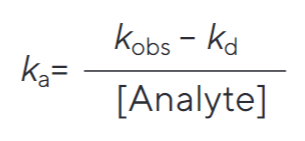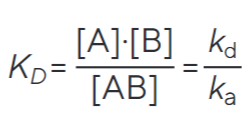octet-biomolecular-binding-kinetics-application-note-4014-en-1—data.pdf
kobs is the observed rate constant. At the same time AB complex is forming, it also decays back to A and B. The term kobs reflects the overall rate of the combined association and dissociation of the two binding partners.
octet-biomolecular-binding-kinetics-application-note-4014-en-1—data, page 8
- This PDF uses observed rate constant rather than ka as done by a sample calculation of SPR (another pdf)

- Solve this equation to get = the equation is specific to association
- A single value would be collected for each analyte concentration
- The paper quotes that “A is the asymptote of the binding curve”
Comparing this equation to Pasted image 20250424154424.png from SPR-Pages - Data fitting methods, the following conclusions can be made:
- t can be scaled to account for time taken for the association phase to start (time measurement may have started pre-emptively, only producing a baseline signal)
- A is simply R_eq, the new baseline that is achieved after the association phase has finished
- Similar to K_m, this can either be fitted or it can be experimentally observed

- Solve this equation to get = the equation is specific to dissociation
- A is the same R_eq asymptote prior to the start of the dissociation phase
- This would be globally fit across different analyte concentrations, because is inherently constant for different analyte concentrations

- Use this equation to solve for
- With varying , varying analyte concentrations, and single estimate, can be calculated
- This is derived form the relationship:

- Use this equation to solve for